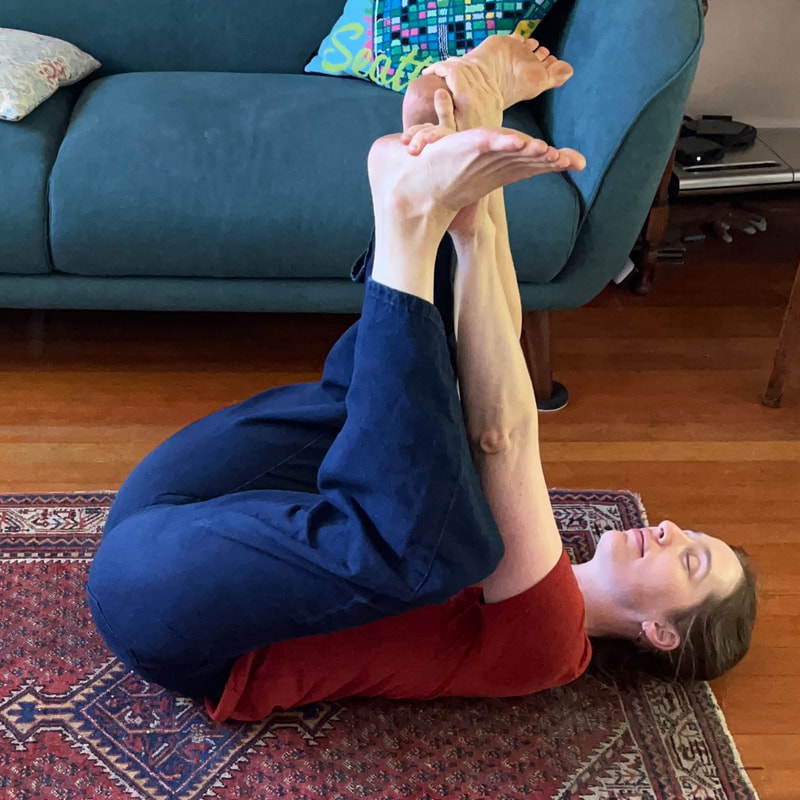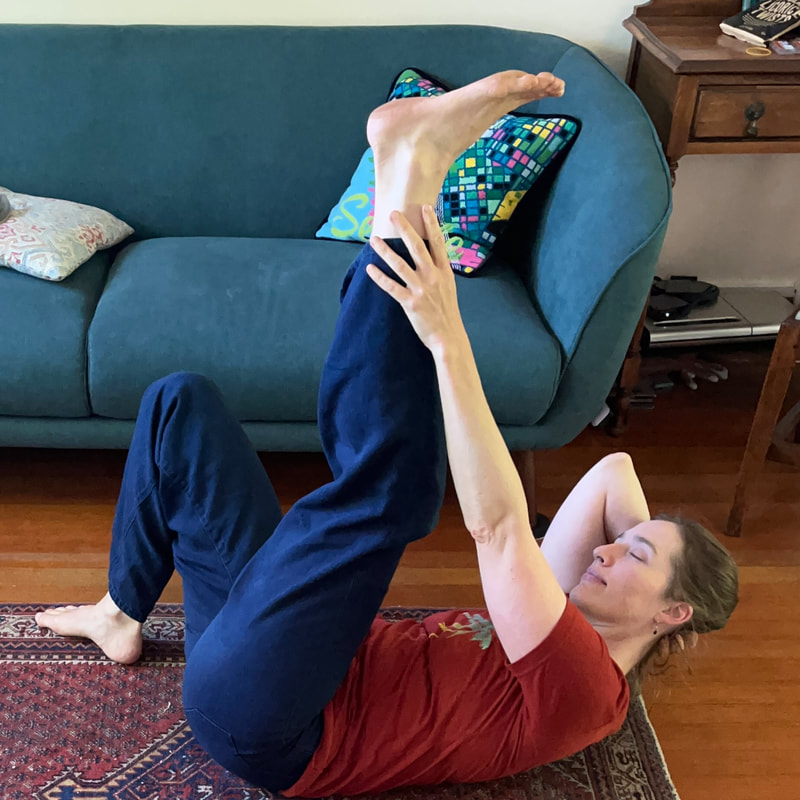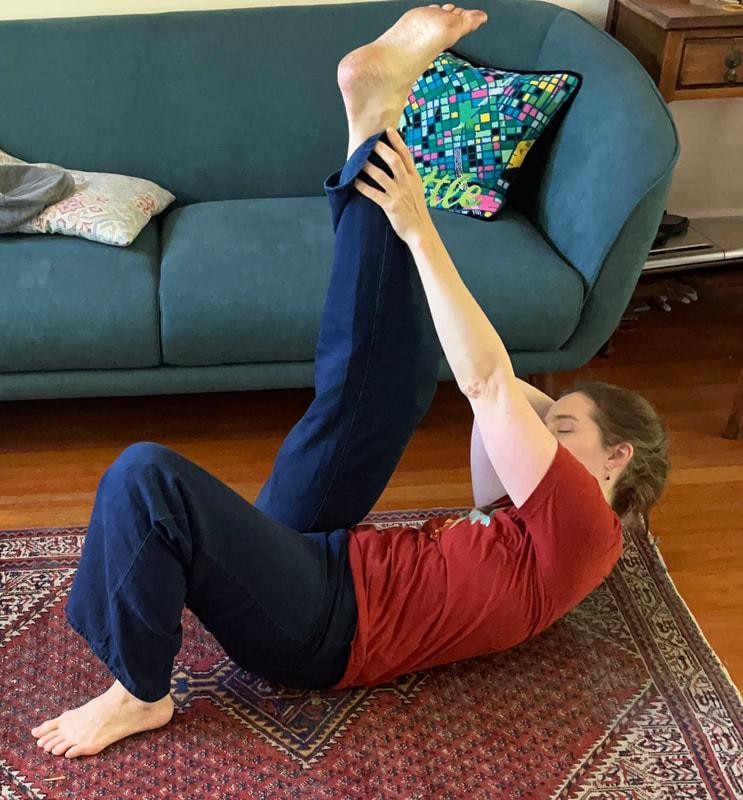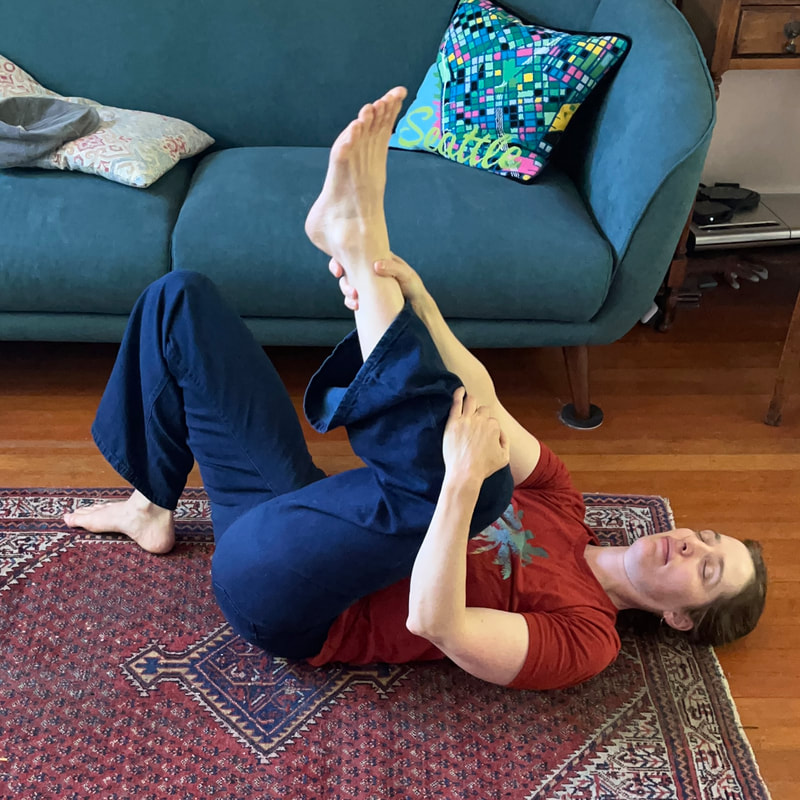|
A very quiet and slow class today. Please do less than you think you should, and remain committed to including your core, center, ribs, and whole self in the movements, even when the instructions do not say this!
Lessons that focus on the pelvis are always beneficial for everything below and above. When the hips move well, the knees are able to stick to their job: hinge. When hips don't move well, then we often find knee pain, some times ankle disorganization, and often issues with the jaw, and spine. The pelvis is at the root of much. My trainer, Richard, used to say "you are where your pelvis is" -- try moving around and see. If you put your head in a room, for example, are you really there? What about if you step in? Available on Patreon: patreon.com/heatherdanso In this lesson we clarify the location and movement of the hip joints and find more availability in the ankles, and participation in the low ribs, sternum, and upper chest. Now, of course, that means that the primary place of focus in the hip joints is only the beginning, and learning to facilitate the movement in the hips by softening the rest of you can transform your walking, sitting, and general sense of well-being. Two recordings available atpatreon.com/heatherdanso . We spend more time on some of the stranger movements at the end.
The final class of the summer is a whole lot of rolling, using arching, rounding, lengthening, shortening, and the leverage of our hips. Have fun! This is sourced from many places, and is an amalgam of other lessons. More to come, another time. Audio here: patreon.com/heatherdanso Tonight's lesson is a standing lesson mainly. When Feldenkrais was teaching ATM (Awareness through Movement lessons) to people who had returned from WWII, he would start with standing lessons. For people dealing with anxiety or trauma, they are often a little more accessible, because lying on the floor with eyes closed might not feel so possible. For us, they are opportunities to work with the way gravity moves through us actively. We often lie down, which is really standing, without all the work. Here, we will have all the moving parts of the dynamic relationships as we move in gravity. We'll move slowly like sloths. This will help us reorganize our hip joints, our feet, our legs, our spines, and ultimately improve our standing postures. 1. Have a chair nearby, especially if you have any issue with balance. You may not need it, but it's nice to have. Most of us used a wall at least once or twice. 2. Take of your socks, so you don't slip! Or, work on a sticky mat for padding, particularly if the hard floor is a bit hard on your bones. 3. Remember to organize with your normal breath, not a larger breath. Long and deep breaths may make you feel lightheaded. If you do feel this way, please sit down and take a nice long break. 4. One of the primary intentions of these classes is to downregulate the habitual places we keep tension, so keep your attention both specific and general - partly on the movement we are doing, and partly on where else you feel movement, where you can soften: your belly, your jaw, your hands, your shoulders. 5. Pay attention to your heel being aligned underneath the hip socket as best you can, particularly at the end of the lesson when you are making circles. Learning is more important than doing it right.
On one level, we are making friends with our whole leg, lower leg, foot and ankle. On another level, we are softening the chest, lengthening the back--lowering the static along the back body including back of the leg. This is a good moment to consider "reciprocal inhibition" - the principle that when the muscle on one side is working, the muscles on the other (ideally) soften. So, when we are lifting the head, we are engaging (gently) the front of us, which encourages the back of us to soften. And when we stand, things are recalibrated. What does that feel like? Perhaps greater stability with less work. You might feel like putting your socks on has suddenly become much more graceful, with your balance improved. Your hip joints may feel alive and softly present. Or, perhaps you feel how soft your lower ribs are, and how easy breathing is. Maybe something different? Here's a photo reminder of some of the possible shapes you may make (imagine me setting the timer on my phone and rushing to the floor! You'll probably be more relaxed. . .). Just so you know, these are after I have done this lesson--you may start with your legs much more bent than this. We finished with some variations of rolling and twisting for integration, and a wee chat among ourselves, which is not included in the recording.
This class is an exploration of various positions, and how we send the breath into the chest, and into the abdomen (an anatomical impossibility, but a useful image) --sometimes called seesaw breath in other lessons. The recording is edited for this evening (I've taken out the 5 minutes when we were off line), and is posted below in audio only. Meanwhile, here is an explainer video to help you understand a few things that are going on when we breathe, and a few reasons why we would want to do a lesson that takes on the disturbances that many of us have: tightness in the intercostal muscles, for example, or only breathing in the chest or the abdomen. What this class does not do is teach you how to breathe: why? Because Feldenkrais classes give you many experiences to learn within, so that what emerges is an organization that YOU choose. This avoids people mistakenly taking on one way, thinking it is the right way, and adapting that one way to meet all situations. After all, we need many ways to breathe, an many shapes to be in to meet all the demands of our lives. One right way isn't enough. Knowing what is possible, and trying many things, is what feeds our nervous system's bank of choices to choose from, building wise body-minds. If you would like to revisit the ideas of this lesson, here is an idea: 1. Try the lesson in your bed. 2. Try one position that you remember, and experiment with the seesaw breathing maneuver slowly, then quickly. Hint: avoid arching your back when breathing into your abdomen. If you feel a bit sore in your back, it’s a possibility that you are doing something unnecessary there. Try placing one of your hands behind your low back to feel what is going on as you do that. See if you can soften there. The audio for this is on Patreon: Heather Danso Emanuel GCFP | Creating Movement lessons & puzzles for health and wellness | Patreon
For this lesson, you'll need wingspan (room to reach your arms. Only the audio lesson will be available on the blog. I'll upload some photos/videos of the movements so that you can see an idea of what you'll be doing. However, if you don't have the video, then you'll have the opportunity to become confused, which is not a bad thing! "If you are not confused, you are not learning". Find some length in your neck, and where did that come from? Must be something about the ribs, as the movements we did today seemingly target the shoulders, but truthfully, the constraint is something more: What needs to move to make this easy? Where can I soften? How do I use my whole self?
Today's lesson is a balancing of the muscles that fold us, and the muscles that hold us up - in other words, we are organizing, discerning, and coordinating the muscles along the spine. That being said, many things happen: the diaphragm is addressed in relation to folding and twisting. In twisting, there are elements of side bending, of curling, and of backbending, so it is a lovely way to actually lower the unnecessary work along the spine.
Did you feel taller? Did your head feel on differently? Did you find more freedom in your thoracic spine and did that impact your ability to twist and to roll your head? This lesson is now on Patreon It was so lovely seeing you this morning. We did a lesson rooted in a series of classic lessons for balancing extensors (the muscles that you use to shorten the back) and flexors (the muscles you use to curl like for a sit up). We did this through twisting--a lesson that makes a huge difference for the sense of ease throughout the whole nervous system, and will affect the way you carry your head, turn, stand, and your overall sense of ease.
The class begins around 1:48 (the first 2 minutes is a little intro to how to approach movements in ATM--without expectation, with space between what I suggest, and what you do. Looking forward to being with you next week! Begins with an exploration of standing and weight shifting. When we discuss in the beginning, there are at least three ways to shift your weight side to side: 1. Like a tree, all one long pole from ankle to head, shifting side to side with most of the movement happening in the ankle. 2. Swinging the head in the opposite direction as a counter balance, like a large C-shape. This is how we balance in side bending standing poses in yoga. (It is almost a subset of #3) 3. Leaving the head in the middle, doing all the shifting in the vertebrae and hips, legs, and ankles. This is a movement that we do in very well-organized walking. The movement lesson begins around 10-12 minutes, after scanning in lying, playing in standing shigting weigh, and scanning again. We find our way onto forearms and knees--a demanding position. This is a compound lesson with elements from a few ATMs, so no formal name or source. TAKE IT EASY. Remember to take breaks. To have the full length class, download the file (it is 1 hour)
|
HOW-TORecorded at public classes, All audio classes are now on Patreon. Please read the HOW-TO before doing a lesson. Archives
April 2024
Categories
All
|
||||||||||||||||||||||||||||||
Heather Emanuel, GCFPSchedule Appointment
|
|











 RSS Feed
RSS Feed